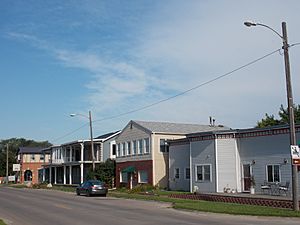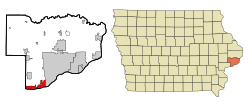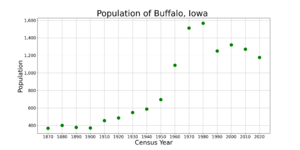Buffalo, Iowa facts for kids
Quick facts for kids
Buffalo, Iowa
|
|
|---|---|

Buildings along Front Street
|
|

Location of Buffalo, Iowa
|
|
| Country | |
| State | |
| County | Scott |
| Area | |
| • Town | 6.81 sq mi (17.63 km2) |
| • Land | 6.77 sq mi (17.54 km2) |
| • Water | 0.04 sq mi (0.10 km2) |
| Elevation | 564 ft (172 m) |
| Population
(2020)
|
|
| • Town | 1,176 |
| • Density | 173.68/sq mi (67.06/km2) |
| • Metro | 382,630 (135th) |
| Time zone | UTC-6 (Central (CST)) |
| • Summer (DST) | UTC-5 (CDT) |
| ZIP code |
52728
|
| Area code(s) | 563 |
| FIPS code | 19-09235 |
| GNIS feature ID | 0454951 |
Buffalo is a town in Scott County, Iowa, United States. The population was 1,176 at the 2020 census. Buffalo is located on the Mississippi River. The town is a part of the Quad Cities Metropolitan Area. It is the home town of WWE legend Seth Rollins
History
Steamship captain Benjamin W. Clarke settled the area of Buffalo in 1833. It was claimed following the 1833 Black Hawk Purchase which opened the region to non-native settlers. In 1836, Clarke sold a 2/3 interest in 90 acres of land to Captain E.A. Mix and Dr. Pillsbury and collectively the three men platted the town of Buffalo after Buffalo, New York. This was the first town to be platted in Scott County. The town was hopeful for a county seat but found itself on the Western edge of Scott County after its districting in 1837. This made the town unsuitable for the county seat compared to the centrally located Davenport.
The Buffalo County Public School District #1 opened in the town in 1836. Coal deposits were discovered in 1834 and sold to passing steamboats. A post office was opened in the town in 1836. The first criminal trial in Scott County was held in Buffalo in 1836 for petty theft.
Geography
Buffalo's longitude and latitude coordinates
in decimal form are 41.459231, -90.721244.
According to the United States Census Bureau, the city has a total area of 6.49 square miles (16.81 km2), of which 6.45 square miles (16.71 km2) is land and 0.04 square miles (0.10 km2) is water. This is the only place where the Mississippi River runs chiefly from east to west instead of south or southwesterly.
Demographics
| Historical populations | ||
|---|---|---|
| Year | Pop. | ±% |
| 1870 | 368 | — |
| 1880 | 400 | +8.7% |
| 1890 | 379 | −5.2% |
| 1900 | 372 | −1.8% |
| 1910 | 456 | +22.6% |
| 1920 | 487 | +6.8% |
| 1930 | 547 | +12.3% |
| 1940 | 588 | +7.5% |
| 1950 | 695 | +18.2% |
| 1960 | 1,088 | +56.5% |
| 1970 | 1,513 | +39.1% |
| 1980 | 1,567 | +3.6% |
| 1990 | 1,250 | −20.2% |
| 2000 | 1,321 | +5.7% |
| 2010 | 1,270 | −3.9% |
| 2020 | 1,176 | −7.4% |
| Source: and Iowa Data Center Source: |
||
2020 census
As of the census of 2020, there were 1,176 people, 458 households, and 329 families residing in the city. The population density was 173.7 inhabitants per square mile (67.1/km2). There were 499 housing units at an average density of 73.7 per square mile (28.5/km2). The racial makeup of the city was 90.1% White, 0.7% Black or African American, 0.2% Native American, 0.5% Asian, 0.0% Pacific Islander, 1.1% from other races and 7.4% from two or more races. Hispanic or Latino persons of any race comprised 6.0% of the population.
Of the 458 households, 31.2% of which had children under the age of 18 living with them, 50.7% were married couples living together, 7.9% were cohabitating couples, 22.3% had a female householder with no spouse or partner present and 19.2% had a male householder with no spouse or partner present. 28.2% of all households were non-families. 21.0% of all households were made up of individuals, 9.4% had someone living alone who was 65 years old or older.
The median age in the city was 41.3 years. 26.3% of the residents were under the age of 20; 3.5% were between the ages of 20 and 24; 25.0% were from 25 and 44; 29.5% were from 45 and 64; and 15.7% were 65 years of age or older. The gender makeup of the city was 49.9% male and 50.1% female.
2010 census
As of the census of 2010, there were 1,270 people, 499 households, and 336 families living in the city. The population density was 196.9 inhabitants per square mile (76.0/km2). There were 527 housing units at an average density of 81.7 per square mile (31.5/km2). The racial makeup of the city was 97.2% White, 0.5% African American, 0.1% Native American, 0.2% Asian, 0.3% from other races, and 1.7% from two or more races. Hispanic or Latino of any race were 2.5% of the population.
There were 499 households, of which 34.7% had children under the age of 18 living with them, 51.7% were married couples living together, 10.2% had a female householder with no husband present, 5.4% had a male householder with no wife present, and 32.7% were non-families. 26.3% of all households were made up of individuals, and 12.2% had someone living alone who was 65 years of age or older. The average household size was 2.55 and the average family size was 3.09.
The median age in the city was 37.9 years. 25.5% of residents were under the age of 18; 7.2% were between the ages of 18 and 24; 28.4% were from 25 to 44; 25.7% were from 45 to 64; and 13.1% were 65 years of age or older. The gender makeup of the city was 50.9% male and 49.1% female.
Education
Davenport Community School District serves Buffalo. Zoned schools include Buffalo Elementary School, Walcott Intermediate School, and Davenport West High School.
Notable person
Colby Lopez, a professional wrestler signed to WWE under the ring name Seth Rollins, was raised in Buffalo.
See also
 In Spanish: Buffalo (Iowa) para niños
In Spanish: Buffalo (Iowa) para niños


